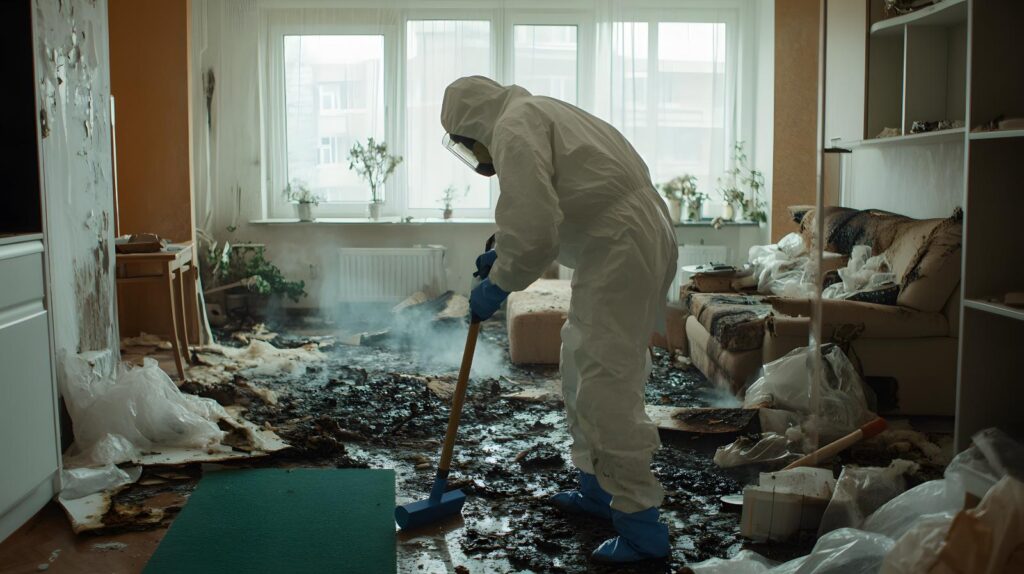
Contents
Did you know that nearly 50% of homeowners experience significant damage after a fire or water incident? It’s vital to act quickly and safely during the cleanup process. By following updated tips for emergency damage restoration, you can protect your health and belongings. Understanding how to assess damage and prioritize tasks can make all the difference in your recovery journey. Let’s explore the essential steps to take when disaster strikes.
Key Takeaways
- Conduct a thorough assessment of damage, documenting findings for insurance claims and restoration efforts.
- Ensure safety by wearing protective gear and maintaining proper ventilation during cleanup.
- Use a vacuum with a HEPA filter for soot removal and consider professional cleaning for fabrics.
- Extract standing water promptly and utilize fans and dehumidifiers to prevent mold growth.
- Create a detailed inventory of damaged items, prioritizing salvageable ones for restoration.
Assessing the Damage After a Fire
When a fire occurs, evaluating the damage promptly is essential, as it helps you determine the necessary steps for restoration.
Begin with a thorough fire damage assessment, where you identify the areas affected by flames, smoke, and water. Document everything you see, as this information will be invaluable for insurance claims and restoration efforts.
Next, conduct a structural integrity evaluation. Check for signs of compromised beams, walls, and foundations.
Look for warping or cracking, as these can indicate serious issues. If you’re unsure about safety, it’s wise to consult a professional.
Safety Precautions to Follow
Before diving into cleanup and restoration, it’s crucial to prioritize safety to protect yourself and others.
Following proper safety precautions can help you avoid injuries and guarantee a more efficient recovery process. Here are some key steps to take:
Wear personal protective gear, including gloves, masks, and goggles.
Familiarize yourself with fire safety protocols to respond appropriately in emergencies.
Make sure the area is well-ventilated to minimize inhalation of harmful substances.
Use caution when handling debris, as sharp objects may be present.
Keep a first aid kit nearby in case of minor injuries.
Cleaning and Removing Soot and Smoke Residue
As smoke and soot can permeate surfaces and materials, tackling their removal promptly is essential for restoring your space. Start by gathering the right supplies, including gloves, masks, and appropriate cleaning agents. Use a vacuum with a HEPA filter to remove loose soot from hard surfaces. For deeper cleaning, follow the strategies below:
| Task | Method | Notes |
|---|---|---|
| Soot Removal | Dry sponge or cloth | Don’t rub; blot instead |
| Smoke Deodorization | Activated charcoal or baking soda | Leave overnight for best results |
| Walls and Ceilings | Water and vinegar solution | Test on small area first |
| Fabrics | Professional cleaning | Avoid washing at home |
Addressing Water Damage From Firefighting Efforts
After tackling the removal of smoke and soot, you may notice the next challenge: water damage from firefighting efforts.
It’s crucial to address this promptly to prevent further issues.
Here’s how you can manage water damage effectively:
- Start with water extraction to remove standing water.
- Use fans and dehumidifiers for moisture control.
- Inspect hidden areas like walls and carpets for trapped moisture.
- Check for mold growth, which can develop quickly in damp conditions.
- Document any damage for insurance claims.
Restoring Your Home and Belongings
Once you’ve addressed the immediate effects of water damage, it’s time to focus on restoring your home and belongings.
Start by creating a home inventory, listing all your items and noting their condition. This will help you identify salvageable items and those that need replacement.
Next, prioritize what can be saved. Clean and dry salvageable furniture and belongings promptly to prevent mold growth. Use fans, dehumidifiers, and sunlight to speed up the drying process.
For sentimental items like photographs or documents, consider professional restoration services if they’re damaged.
Don’t forget to consult your insurance policy to understand what’s covered. Keep receipts for any repairs or replacements, as these may be reimbursable.
With a clear plan and determination, you can restore your space and reclaim your belongings, turning a challenging situation into an opportunity for renewal and revitalization.
Summary
In the aftermath of a disaster, remember the phoenix rising from the ashes; you too can restore your home and belongings. By prioritizing safety and thorough assessments, you set the stage for effective cleanup and restoration. Don’t hesitate to seek professional help for those cherished items, and keep an organized inventory to ease the process. With diligence and care, you’ll transform your space from chaos back to comfort, ready to embrace new memories.
Recent Posts
Pricing Insights for Damage Restoration Services
When unexpected events disrupt your life, steering through the costs of damage restoration can feel
Budgeting for Blaze Cleanup: A Trusty Guide
Budgeting for blaze cleanup is like steering through a maze—complex and overwhelming but attainable with
Top Storm Damage Repair Techniques for Homeowners
When storms release their fury, the aftermath of storm damage can feel overwhelming, much like
